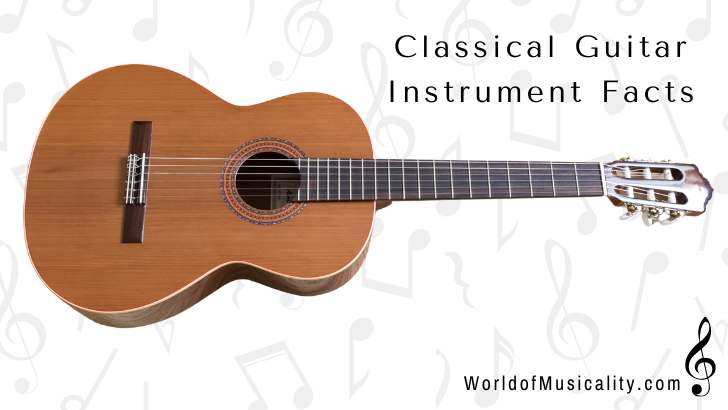
Classical Guitar Description
The Classical guitar is a string instrument known for its warm, mellow tone and nylon strings.
It features six nylon strings, hollow body with a sound hole, a wide neck, and a flat fingerboard. The body shape is typically hourglass-like with a rounded back and flat top.
This guitar is commonly used in classical, flamenco, and folk music, and is characterized by its fingerstyle playing technique.
Detailed Instrument Description
| Instrument Name | Classical Acoustic Guitar |
| Instrument Family | String |
| Alternative Names | The classical acoustic guitar is often simply referred to as the “classical guitar.” In Spanish-speaking countries, it is known as the “guitarra clásica” or “guitarra española.” |
| Geographical Presence | The classical acoustic guitar is played worldwide, being an essential part of Western classical music traditions. It is prominently featured in Europe, Latin America, and North America, and is also popular in various other musical cultures. |
| Instrument Classification | The classical acoustic guitar falls under the Hornbostel-Sachs classification system as 321.322, identifying it as a plucked string instrument. This system classifies musical instruments based on how they produce sound, with the classical guitar classified as a chordophone where sound is produced by vibrating strings. |
| Unique Features | The classical acoustic guitar is known for its nylon strings, which produce a softer and warmer sound compared to steel strings. It has a wide neck and flat fingerboard, which facilitate fingerstyle playing. The body is typically made of wood, with a distinctive rosette around the sound hole. |
| Sound Characteristics | The classical acoustic guitar produces a warm, mellow, and rich sound. Its tone is softer and more resonant compared to steel-string guitars, making it ideal for classical and fingerstyle music. Its nylon strings contribute to its unique timbre and playability. |
| Typical Music Genres | The classical acoustic guitar is primarily used in classical music, flamenco, and folk music. It is also found in Latin music, traditional Spanish music, and occasionally in contemporary and popular music. |
| Components | Body, Sound Hole, Neck, Fingerboard, Frets, Strings, Bridge, Tuning Pegs, Nut |
| Construction | The classical acoustic guitar is traditionally made of various types of wood, such as spruce or cedar for the top, and rosewood, mahogany, or maple for the back and sides. The neck is usually made of mahogany or cedar, and the fingerboard is typically made of ebony or rosewood. The strings are made of nylon, with the lower three strings wound with metal. |
| Size and Weight | The size of the classical acoustic guitar typically ranges from 95 to 100 centimeters (37 to 39 inches) in total length. The weight varies between 1.2 to 1.8 kilograms (2.6 to 4 pounds), depending on the materials used. |
| Variations and Customizations | Variations of the classical acoustic guitar include different sizes, such as 3/4 and 1/2 size guitars for younger players. Customizations might include different types of wood for varied sound quality, decorative inlays, and unique rosette designs around the sound hole. |
| Instrument History | The classical acoustic guitar has its origins in the early guitars of the Renaissance and Baroque periods. It evolved significantly during the 19th century, with luthiers like Antonio Torres Jurado establishing the modern classical guitar’s design. The instrument gained prominence in the 20th century through the works of composers like Francisco Tárrega and performers like Andrés Segovia. |
| Similar Types of Instrument | Acoustic Guitar, Flamenco Guitar, Steel-String Guitar |
| Playing Technique | The guitarist uses fingers or a thumb to pluck the strings, producing sound. Fingerstyle playing is common, involving the use of the thumb, index, middle, and ring fingers. Techniques such as tremolo, rasgueado, and harmonics are frequently employed to add expression and complexity to the music. |
| Notable Composers | Francisco Tárrega, Heitor Villa-Lobos (below), Joaquín Rodrigo |

| Famous Works | Tárrega’s “Recuerdos de la Alhambra,” Villa-Lobos’ “Etudes and Prelude No1,” Rodrigo’s “Concierto de Aranjuez” |
| Maintenance | Regular maintenance includes tuning the strings, cleaning the body and fingerboard, and occasional string replacement. The guitar should be stored in a case to protect it from humidity and temperature changes. Proper care of the wood and regular checks of the tuning pegs and bridge are essential. |
| Learning Difficulty | Moderate to high; requires coordination and dexterity to manage finger positions and plucking techniques. Learning proper hand techniques, fingerstyle playing, and music reading are essential for effective playing. |
| Prominent Players | Andrés Segovia, Julian Bream, John Williams |
| Notable Performances | Notable performances include concerts by prominent classical guitarists at festivals worldwide, such as the Andrés Segovia International Guitar Competition and the Guitar Foundation of America Festival. |
| Famous Orchestras/Bands | Prominent ensembles featuring the classical guitar include the Los Angeles Guitar Quartet, the Brazilian Guitar Quartet, and various chamber music groups. |
| Price Range | Classical acoustic guitars range from $100 to $10,000 or more, depending on the craftsmanship, materials, and features. Beginner models start around $100, while professional models with custom features can exceed $10,000. |
| Interesting Facts | The instrument’s body typically features a decorative rosette around the sound hole, which is often unique to each guitar. |







